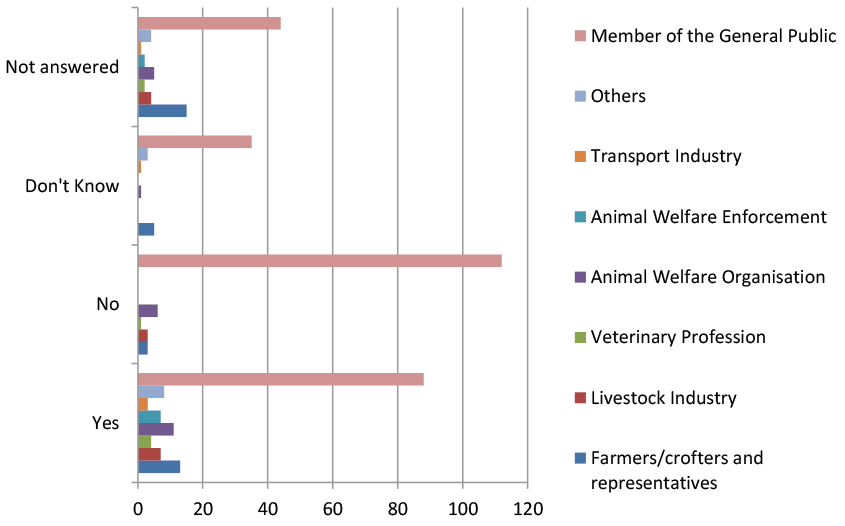Welfare of animals during transport - consultation: summary report
Analysis of the responses received to the full public consultation, between 4 December 2020 to 26 February 2021, of the Farm Animal Welfare Committee's opinion on the welfare of animals during transport.
Question 8
Do you agree with the Scottish Government’s position on transport practices and proposed course of action? Please provide any further relevant information.
It is the view of the Scottish Government that, in principle, all animals of the same species should be afforded the same level of minimum protection regardless of whether they are being moved for commercial purposes or for other purposes.
We note that current domestic legislation does provide some animal welfare protections to animals being transported not in connection with an economic activity. At the same time we recognise that statutory regulation should be applied in a proportionate and risk-based way and it is not necessarily the case that the same statutory regulatory requirements should apply to everyone in every situation in order to achieve the same welfare outcomes and minimum protections.
Non-statutory regulation or guidance may be suitable in some instances, and we should review where the boundaries of statutory regulation lie, and consider how to apply a risk based and proportionate approach in relation to authorisations, Certificates of Competence and other aspects of statutory regulation.

Of the 311 responses to this question, 45.3% were in favour of the Scottish Government’s position on transport practices and proposed course of action. 40.2% were not in favour and 14.5% did not express a view.
A number of enforcement agencies noted that ‘proportionate and risk-based enforcement’ was already routine, but requests were made for the “recommendations to be supported by statutory or advisory Guidance Documents issued by the Scottish Government” (Argyll & Bute Council). However, other comments stated a view that it was “likely to be unrealistic and unenforceable” (Ornamental Aquatic Trade Organisation) for all journeys to be regulated. Four Paws UK favoured regulation, but that “we must assess whether special requirements need to be defined for transports” for a smaller number of animals e.g. “a horse “going on vacation””.
Some equine organisations favoured the proposal of regulating commercial and non-commercial transport. An unnamed organisation suggested three types of journey (less than 65 km; between 65 km and 4 hours; and between 4 and 12 hours) and suggesting that Type 2 authorisation would be “unduly onerous for amateur owners who may travel over 4 hours to attend competitions” and that a derogation might apply.
There were a number of comments provided in relation to the movement of dogs and puppies, which was suggested by some as “the area where stricter legislation could make a big difference” (East Ayrshire Council). Scotland’s Rural College commented that the significant “commercial transport of companion animals does not appear to be covered here”. The “huge market for pet carriage and dog walkers” was suggested for further scrutiny by Aberdeenshire Council; and that view was supported by Dogs Trust in relation to “shorter journeys associated with commercial activities in which dogs are not currently protected i.e. dog walking, doggy day care and home boarding”.
Farmers and their representative shared a general view that the existing derogation for farmers moving their own livestock less than 65 km remains appropriate and that requiring “authorisations and certificates of competence for such would be disproportionate”.
Those organisations, and their individual supporters, who did not favour the Scottish Government’s position did so from opposing positions. Such respondents from the farming and livestock industry sectors considered, in general, that the “present regulations are adequate and no change or enhancement is needed” (unnamed organisation). Respondents from the welfare sector commented that any animal transported has the “same capacities for suffering and experience” (unnamed organisation) as commercially transported animals and that “obtaining the required certification and authorisation in not too onerous” (OneKind).
In addition, three unnamed welfare organisations not in agreement with the Scottish Government position also commented that “protection also needs to apply to the transportation of animals used for scientific purposes including in laboratories”. In that regard, an unnamed veterinary organisation commented that animals transported to the standards of existing guidelines for that sector should have “welfare harms minimised”.
Contact
There is a problem
Thanks for your feedback